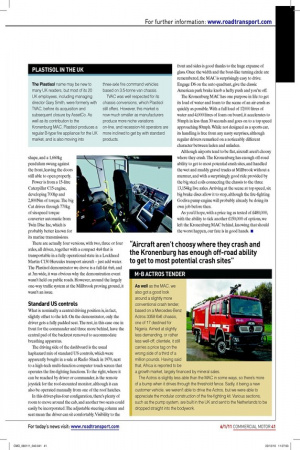Red alert
Page 35

Page 36

If you've noticed an error in this article please click here to report it so we can fix it.
If you were to compile a list of vehicles you never want to see doing the job they were designed for, the airport crash tender would come quite high up. So when Plastisol invited us to try out one of its latest top-of-the-range products on your behalf, we felt it would be churlish to refuse
The market for these mega-machines, about 450 units a year, is global, and the Kronenburg MAC (Major Airield Crash) is a correspondingly international effort. The chassis is from KME, a leading supplier of specialist vehicles from Nesquehoning, Pennsylvania; the main engine from Caterpillar; the ire-ighting equipment from Plastisol’s UK operation in Chorley, Lancashire; and the cab is built and the whole thing assembled at Plastisol’s headquarters in the south of the Netherlands.
The cab is constructed entirely from composite materials, notably vacuum-formed, glass-reinforced polyester, with no metal framework at all. The company has its own crash test facility and the tests carried out are impressive. They include resting 12,000kg on the roof, with no lasting effect once the plastic springs back into shape, and a 1,660kg pendulum swung against the front, leaving the doors still able to open properly.
Power is from a 15-litre Caterpillar C15 engine, developing 700hp and 2,800Nm of torque. The big Cat drives through 770kg of six-speed torque converter automatic from Twin Disc Inc, which is probably better known for its marine transmissions.
There are actually four versions, with two, three or four axles, all driven, together with a compact 4x4 that is transportable in a fully operational state in a Lockheed Martin C130 Hercules transport aircraft – just add water. The Plastisol demonstrator we drove is a full-fat 6x6, and at 3m wide, it was obvious why the demonstration event wasn’t held on public roads. However, around the largely one-way trafic system at the Millbrook proving ground, it wasn’t an issue.
Standard US controls
What is nominally a central driving position is, in fact, slightly offset to the left. On the demonstrator, only the driver gets a fully padded seat. The rest, in this case one in front for the commander and three more behind, have the central pad of the backrest removed to accommodate breathing apparatus.
The driving side of the dashboard is the usual haphazard mix of standard US controls, which were apparently bought in a sale at Radio Shack in 1970, next to a high-tech multi-function computer touch screen that operates the ire-ighting functions. To the right, where it can be reached by driver or commander, is the remote joystick for the roof-mounted monitor, although it can also be operated manually from one of the roof hatches.
In this driver-plus-four coniguration, there’s plenty of room to move around the cab, and another two seats could easily be incorporated. The adjustable steering column and seat mean the driver can sit comfortably. Visibility to the front and sides is good thanks to the huge expanse of glass. Once the width and the boat-like turning circle are remembered, the MAC is surprisingly easy to drive. Engage D6 on the auto quadrant, give the classic American park brake knob a hefty push and you’re off.
The Kronenburg MAC has one purpose in life: to get its load of water and foam to the scene of an air crash as quickly as possible. With a full load of 17,000 litres of water and 4,000 litres of foam on board, it accelerates to 50mph in less than 30 seconds and goes on to a top speed approaching 80mph. While not designed as a sports car, its handling is free from any nasty surprises, although regular drivers remarked on a noticeably different character between laden and unladen.
Although airports tend to be lat, aircraft aren’t choosy where they crash. The Kronenburg has enough off-road ability to get to most potential crash sites, and handled the wet and muddy gravel tracks at Millbrook without a murmur, and with a surprisingly good ride provided by the big steel coils connecting the chassis to the three 13,154kg live axles. Arriving at the scene at top speed, six big brake discs allow it to stop, although the ire-ighting Godiva pump engine will probably already be doing its own job before then.
As you’d hope, with a price tag as tested of £480,000, with the ability to tick another £150,000 of options, we left the Kronenburg MAC behind, knowing that should the worst happen, our fate is in good hands. ■














































